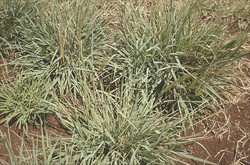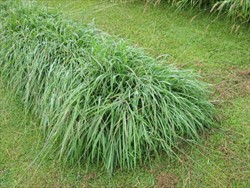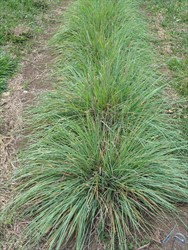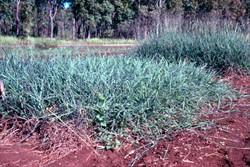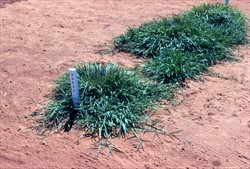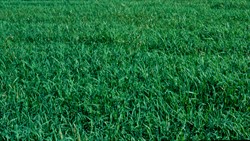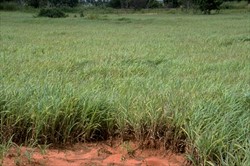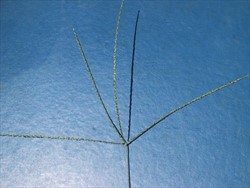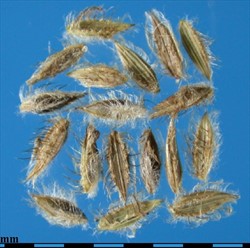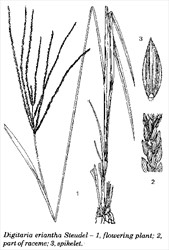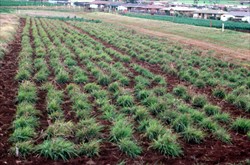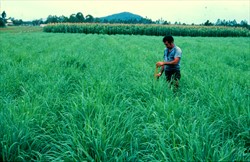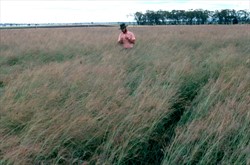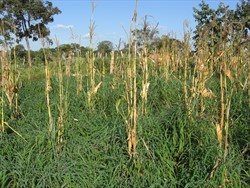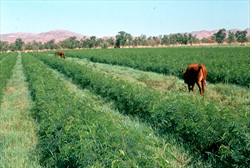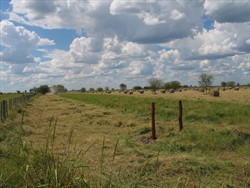Digitaria eriantha
Tropical Forages
Digitaria eriantha Steud.
Digitaria decumbens Stent; Digitaria eriantha Steud. subsp. eriantha Steud.; Digitaria eriantha Steud. subsp. pentzii (Stent) Kok; Digitaria eriantha Steud. subsp. stolonifera (Stapf) Kok; Digitaria eriantha Steud. var. stolonifera Stapf; Digitaria geniculata Stent; Digitaria glauca Stent; Digitaria pentzii Stent; Digitaria pentzii var. minor Stent; Digitaria pentzii var. stolonifera (Stapf) Henrard; Digitaria polevansii Stent; Digitaria seriata Stapf; Digitaria setivalva Stent; Digitaria smutsii Stent; Digitaria stentiana Henrard; Digitaria umfolozi D.W. Hall; Digitaria valida Stent; Syntherisma erianthum (Steud.) Newbold
Family: Poaceae (alt. Gramineae) subfamily: Panicoideae tribe: Paniceae subtribe: Anthephorinae.
Perennial grass incorporating a number of morphologically different former species (see below). Stoloniferous with internodes glabrous or hairy, or tufted-rhizomatous with rhizomes knotty and unbranched; culms, simple or branched, 35‒120 (‒180) cm tall. Basal leaf sheaths mostly silky and hairy (rarely glabrous); leaf blades 5‒60 cm long, 1.5‒14 mm wide, linear, apex attenuate, glabrous or with few hairs, scabrous; ligule an unfringed membrane, 2‒5 mm long. Inflorescence a digitate (single whorl) or subdigitate (2 or more whorls, axis to 3 cm long) panicle comprising 3‒17 racemes, 5‒20 cm long. Spikelets paired, 2‒4 mm long; lower glume a membranous scale to 0.5 mm long, upper glume ½– ⅔ as long as spikelet; upper glume and lower lemma purple and silvery, covered with 1 mm long hairs. About 3 million seeds/kg.
Distinguishing characteristics of formerly recognized species
D. decumbens: Origin South Africa (Mpumalanga). Strongly stoloniferous with culms to 120 cm; leaf blades 10‒25 cm × 2‒7 mm; 5‒10 racemes/panicle; raceme to 13 cm long; spikelet 2.7‒3 mm long, minute appressed hairs.
D. eriantha: Origin South Africa, east Africa. Tufted, sometimes short stolons with culms to 80 cm; leaf blades 8‒20 cm × 2‒4 mm; 3‒9 racemes/panicle; raceme 6‒15 cm long; spikelet 3‒3.5 mm long with spreading marginal hairs.
D. pentzii: Origin South Africa, east Africa. Tufted or stoloniferous with culms to 120 cm; leaf blades to 30 cm long × to 6 mm wide; 3‒14 racemes/panicle; raceme to 18 cm long; spikelet 2.5‒3.5 mm long, with erect (not spreading) marginal hairs.
D. setivalva: Origin east and south tropical Africa. Stoloniferous with culms to 80 cm; leaf blades 3‒15cm × 2‒5 mm; 3‒11 racemes/panicle; raceme 2‒20 cm long; spikelet 2.5‒3.5 mm long with long, spreading marginal hairs.
D. smutsii: Origin South Africa. Tufted (stolons absent) with culms to 150cm; leaf blades to 50 cm × 8‒12 mm; 4‒14 racemes/panicle; raceme to 17cm long; spikelet 3.5 mm long with short, non-spreading marginal hairs.
D. valida: Origin South Africa. Stoloniferous with culms to 130 cm. Resembles D. eriantha Steud., but is larger with longer leaves and larger spikelets; viewed by some as robust form of D. pentzii.
D. umfolozi D.W. Hall: Not recognised by major taxonomic authorities, but described in some literature as a stoloniferous species with hairy leaves, growing to 70 cm tall, from KwaZulu Natal, South Africa; probably synonymous with D. eriantha.
Similar species
D. eriantha: nerves of the lower lemma are smooth.
D. milanjiana: nerves of the lower lemma scaberulous.
Africa: bloukruisgras, gewone vingergras, hoenderspoor, hoenderspoorgras, hoenderspoort, hoenderspoortgras, kleinvingergras, kortbeen hoenderspoort, kortbeen hoenderspoortgras, kortbeenhoenderspoor, kortbeenhoenderspoorgras, kruisgras, smuts vingergras (D. smutsii); vingergras, wolvingergras (Afrikaans); mangole maseka (Tswana); mmoyane (South Sotho); moeane (Sotho); isikonko (Zulu)
English: common finger grass, digit grass; pangola grass, pongola finger grass, pongola grass (D. decumbens); woolly finger grass (D. eriantha, D. pentzii, D. setivalva); smuts finger grass (D. smutsii); giant pangola grass (D. valida)
Europe: digitaire (French); Pangolagras (German)
Latin America: capim Angola, capim canjica, capim pangola, pangola gigante, pangolinha (Brazil); pangola, pasto pangola; pangola gigante (D. valida); pangola lanudo (D. pentzii)(Spanish)
Native:
Africa: Angola; Botswana; Mozambique; Namibia; South Africa; Zimbabwe; Swaziland
Naturalized:
Pacific: Hawaii
Caribbean: Cuba; Puerto Rico; Virgin Islands (U.S.)
South America: Argentina; Brazil; Colombia; Costa Rica; Paraguay
Cultivated:
Australasia: Australia (New South Wales, Northern Territory, Queensland)
Africa: South Africa; Zimbabwe
Northern America: USA (Florida)
Central America: Costa Rica (Guanacaste)
South America: Colombia, Ecuador (Galapagos Islands), Panama, Venezuela
Forage
Permanent pasture species but can be used for grazing, hay or silage. Suitable for cut-and-carry.
Environment
Stoloniferous types provide good ground cover for soil conservation and restoration of heavily disturbed land.
Soil requirements
D. eriantha is largely found on lighter well drained soils (sands, sandy loams, loams and clay loams) but rarely on clays. Seeding types tend to be restricted to sandy soils in their native habitat, possibly because seedlings do not establish readily on heavier soils without disturbance. Both tufted and stoloniferous seeding types are mostly used on sandy soils in cultivation, although they will grow on clay soils, once established. Pangola types are used on a wide range of soils from sands to heavy clays, of low or high fertility. While pH at collection sites range from (4.4‒) 6.0‒7.0 (‒9.1), adaptation may not be universal within the species, but specific to a particular ecotype. In cultivation, the pangola types appear slightly more acid-tolerant and less alkali-tolerant than the seeding types, with a suggested range of (4.5‒) 5.0‒6.0 (‒7), compared with (4.5‒) 5.5‒7.0 (‒8.5) for the seeding types. Pangola has low to moderate salt/alkalinity tolerance, and moderate tolerance of aluminium (to 34% saturation of CEC). The species can survive on soils of relatively low fertility, but responds strongly to fertility improvement.
Moisture
D. eriantha is found in areas with average annual rainfall ranging from 300 to 1,300 mm, although mostly from 450‒800 mm. All types are very drought tolerant. Seeding varieties are mostly used in areas with rainfall from about 750 to 1,000 mm, and the stoloniferous pangola types in both low rainfall environments (±800 mm), but more often in higher rainfall areas (1,200 to >3,000 mm). Pangola types are more tolerant of flooding and waterlogging than seeding types.
Temperature
The species extends from about 14‒34º S, and from near sea level in South Africa to 2,250 m asl in Lesotho. Warm to hot summers, and cold winters, often with frosts, are experienced over most of this distribution. Average annual temperatures are mostly of the order of 16‒24 ºC. D. smutsii types appear to have a lower temperature threshold than pangola types, starting growth earlier in the season and growing longer into periods with cool night temperatures. 'Premier' (a D. smutsii type) is usually planted in subtropical areas with an average annual temperature of 15‒21 ºC, and pangola in subtropics and tropics, with average temperatures from about 19‒24 ºC. 'Mardi' was selected in an area in the wet tropics with an average annual temperature of 26 ºC. Although the species is generally frost sensitive, some difference in frost tolerance and regrowth capacity after frosting among genotypes has been observed.
Light
D. eriantha is generally considered to have low shade tolerance, although some types appear to be more shade tolerant than others, e.g. in Malaysia, 'Mardi' (D. setivalva) rated "medium" for shade tolerance (cf. Urochloa brizantha, U. decumbens, and Setaria sphacelata), while D. decumbens and D. pentzii rated low (cf. Cynodon plectostachyus and U. mutica ).
Reproductive development
In the subtropics, pangola flowers through much of the growing season with a peak in mid-summer, while other genotypes flower in late spring and again in autumn.
Defoliation
All genotypes of D. eriantha are tolerant of heavy grazing. Regular grazing is necessary to maintain quality and to minimise disease incidence. Probably best if the grass is maintained between 10‒15 and 30‒40 cm, although this may not be feasible under sheep grazing. Ideally, it should be grazed every 2‒3 weeks. Stoloniferous cultivars often become "sodbound" and may benefit from periodic cultivation. This can be as radical as is appropriate in the situation, since these types redevelop rapidly from cultivated pieces.
Fire
Tolerant of fire.
Guidelines for establishment and management of sown forages.
Establishment
Many of the stoloniferous types produce little or no seed and must be propagated vegetatively. A bulky stand with a high proportion of culms and ascending or arching stolons is cut by hand or with a forage harvester, and the material spread on a cultivated surface at 0.5‒2 t of green matter per hectare. This is then cultivated into prepared ground and rolled. Alternatively pieces of stolon can be pushed into the soil on about a metre grid. Under good growing conditions, vegetatively planted swards establish rapidly, suppressing weeds in the process. Seeding varieties require a fine, firm, clean seedbed for establishment, to avoid competition in the early stages. Seed is slightly hairy and may not flow readily through some planting equipment. Mixing seed with superphosphate, or sawdust or pelleting facilitates flow. Stoloniferous types establish more readily than tufted ones.
Fertilizer
D. eriantha is tolerant of, but unproductive under low fertility conditions. 'Pangola' responds well to nitrogen, giving linear increases up to 300‒350 kg/ha N. Other types also respond well to improved nitrogen fertility, but perhaps not to the same extent as 'Pangola'. 100‒300 kg/ha N should be applied in split applications according to needs and environmental conditions, rather than in a single application at the beginning of the season. Levels of other nutrients, particularly phosphorus, should also be monitored. Pangola grass was very popular in a number of countries some decades ago, but its use has declined because of the high N fertilizer requirement.
Compatibility (with other species)
Tussock types combine well with other species, but stoloniferous types can be very competitive and suppress companion legumes.
Companion species
Grasses: Usually not planted with other grasses.
Legumes: Different legumes are sown with D. eriantha depending on the genotype of the grass and the environment involved. In the wet tropics, vigorous stoloniferous species such as Grona heterophylla and Arachis pintoi are successful with the pangola types. Aeschynomene falcata, Chamaecrista rotundifolia, Listia bainesii, Trifolium repens and T. subterraneum are more appropriate companions for the sub-tropically adapted tufted types.
Pests and diseases
Susceptibility to rust (Puccinia oahuensis) varies among genotypes. False smut (Ephelis sp.) in seed heads is a minor problem, particularly during prolonged wet periods. Pangola grass is also attacked by the fungi, Mycosphaerella tassina, Piricularia grisea, and Rhizoctonia solani. The most serious disease of D. eriantha is pangola stunt virus, transmitted by whitebacked planthopper (Sogatella furcifera Homoptera: Delphacidae), or S. kolophon. Symptoms are stunting, yellowing, reddening, and twisting of leaves and inflorescences, swelling of small veins, and excessive tillering. Other viruses include digitaria striate cytorhabdovirus (chlorotic spots and stripes), pangola stunt fijivirus, sugarcane mosaic potyvirus, and potato virus Y.
Nematodes include: Belonolaimus longicaudatus (sting nematode), Dolichodorum nigeriensis, Helicotylenchus pseudorobustus, Meloidogyne incognita, Peltamigratus nigeriensis, Pratylenchus brachyurus (root lesion nematode), Rotylenchulus reniformis, and Scutellonema clathricaudatum. However, 'Pangola' is largely resistant to root-knot nematode and is recommended as a rotation crop on sandy soils infested with cotton root-knot nematode (Meloiodogyne incognita). Insects pests include spittlebugs (Tomaspis flavopicta, T. humeralis, Prosapia bicincta), rhodes grass mealy bug (Antonina graminis), chinch bug (Blissus leucopterus), sugarcane aphid (Sipha flava), army worms (Laphigma spp., Spodoptera spp. and Mocis spp.), mole crickets and leafhoppers.
Ability to spread
Spreads by seed and/or stolons depending on genotype.
Weed potential
Generally not considered a serious weed. The stoloniferous type, pangola, is sterile and can only spread vegetatively. While seeding varieties can persist on infertile soil, they are very palatable to grass-eating herbivores.
Nutritive value
D. eriantha is one of the higher quality tropical grasses. As with other grasses, particularly the panicoid species, nutritive value varies with age of material, soil fertility, and genotype. CP values are commonly of the order of 9‒14%, and may exceed 20%, and IVDMD 45‒70%. 'Pangola' has relatively high concentrations of Na in its tissues, compared with many other tropical grasses.
Palatability/acceptability
Most genotypes are very palatable, particularly when young and are preferred to common pangola. Palatability may not be as good in soils of low fertility.
Toxicity
No record of toxicity. Contains low levels of soluble oxalate and therefore has low risk of causing oxalate-related animal health problems, i.e. suitable for horses and lactating cows.
Feedipedia link
Dry matter
DM yields vary with fertility, genotype, and environmental and management conditions, but normally range from about 10 to 20 t/ha, and under ideal conditions may exceed 40 t/ha with high fertilizer inputs.
Animal production
An excellent species for beef and milk production. N fertilized pasture can produce >1,000 kg/ha/yr LWG and 6,000 kg/ha/yr milk, with stocking rates of 2.5‒7.5 animals/ha.
The extreme diversity within D. eriantha makes it difficult to generalize. Presence of ecotype variation, different reproductive modes and a wide geographic distribution imply that an extensive and diverse genetic adaptability for survival under fierce environmental conditions exists within D. eriantha. 2n = 18, 27, 36, 40, 45, 50, 54, 108. In a mixed collection of seeding lines from various parts of Africa, it was found that almost 60% of tufted accessions were diploid (2n = 18 or 20) about 70% of the stoloniferous accessions (2n = 34 or 36) were tetraploid.
D. decumbens: 2n = 30 (27 in 'Transvala'). D. eriantha: 2n = 18, 36, 40. D. pentzii: 2n = 18, 27, 36, 45, 54. D. setivalva: 2n = 18. D. smutsii: 2n = 18, 36. D. valida: 2n = 18, 27, 36, 30.
Seed production by fertile genotypes averages about 190 kg/ha, although header yields of up to 300 kg/ha have been achieved under ideal conditions. Timing of harvest is critical as seed drops when the crop is ripe. Seed should be harvested when seedhead colour changes from green to grey, and the seed becomes easy to rub from the seedhead. Seed crops can be reduced by false-smut (Ephelis sp.), particularly in periods of prolonged wet weather; spraying with benomyl fungicide can limit the damage.
No information available.
- Persistent, productive.
- Drought-tolerant.
- Tolerant of moderate levels of exchangeable aluminium.
- Good cool-season activity in D. smutsii types.
- Tolerant of fire.
- Tolerates short-duration heavy grazing by cattle and sheep.
- Contains low levels of soluble oxalate.
- Pangola types must be planted vegetatively.
- Limited cool season growth in pangola types.
Bogdan, A.V. (1977) Tropical Pasture and Fodder Plants. Longman Inc., New York, USA. p. 111–126.
Dannhouser, C.S. (1988) A review of foggage in the central grass veld with special reference to Digitaria eriantha. African Journal of Range and Forage Science 5:193–196. doi.org/10.1080/02566702.1988.9648140
Gibbs Russell, G.E., Watson, L., Koekemoer, M., Smook, L., Barker, N.P., Anderson, H.M. and Dallwitz, M.J. (1990) Grasses of Southern Africa: An identification manual. Memoirs of the Botanical Survey of South Africa No. 58. Botanical Research Institute, Pretoria, South Africa.
Hacker, J.B. (1992) Digitaria eriantha Steudel. In: Mannetje, L.’t and Jones, R.M. (eds) Plant Resources of South-East Asia No. 4. Forages. Pudoc Scientific Publishers, Wageningen, the Netherlands. p. 121–123. edepot.wur.nl/327785
Hacker, J.B., Williams, R.J. and Coote, J.N. (1995) Productivity in late winter and spring of four cultivars and 21 accessions of Cenchrus ciliaris and Digitaria eriantha cv. Premier. Tropical Grasslands 29:28–33. bit.ly/33OAKDj
Lowe, K.F., Moss, R.J., Cowan, R.T., Minson, D.J. and Hacker, J.B. (1991) Selecting for nutritive value in Digitaria milanjiana. 4. Milk production from elite genotype compared with Digitaria eriantha ssp. pentzii (pangola grass). Australian Journal of Experimental Agriculture 31:603–608. doi.org/10.1071/EA9910603
Pozzobon, M.T., Glatzle, A., Conterato, I.F., Schifino-Wittmann, M.T. and Smiderle, V.G. (2006) Variation in chromosome number and its relationship with agronomic characteristics in a germplasm collection of Digitaria eriantha sensu lato. Tropical Grasslands 40:157–164. bit.ly/2Jnblao
Strickland, R.W. (1974) Performance of southern African Digitaria spp. in southern Queensland. Australian Journal of Experimental Agriculture and Animal Husbandry 14(67):186–196. doi.org/10.1071/EA9740186
Strickland, R.W. and Haydock, K.P. (1978) A comparison of twenty Digitaria accessions at four sites in south-east Queensland. Australian Journal of Experimental Agriculture and Animal Husbandry 18:817–824. doi.org/10.1071/EA9780817
Theunissen, J.D. (1997) Selection of suitable ecotypes within Digitaria eriantha for reclamation and restoration of disturbed areas in southern Africa. Journal of Arid Environments 35:429–439. doi.org/10.1006/jare.1995.0146
'Advance' Released in Australia (1989). Synthetic variety from hybrid between CPI 38869 (seeding type, cv. Premier) and CPI 16778A (good cool season growth, almost sterile genotype). Initially released as 'Apollo' on the basis of slightly higher early season growth than 'Premier'. Produces less seed than 'Premier' and is not used commercially.
'Avanzada INTA' Released in Argentina (1999). No information available.
'Irene' PI 364669 Released in South Africa (1940s). Doornkloof, near Irene, Pretoria. A heterogeneous variety. Difficulties in seed production and establishment.
'Mardi' (PI 299892) Released in Malaysia (1974) Origin South Africa. Formerly classified as Digitaria setivalva. Sometimes listed now as D. milanjiana. Foliage to 70 cm and flowering stems to 1.3 m high. Very leafy, with leaf blades about 20 cm long and 1 cm wide. Selected for superior performance in the wet tropics.
'Mealani' Released in Hawai'i, USA 1970s. Colchicine-induced hexaploid (2n = 54) from pangola (2n = 27). A stoloniferous grass to a height of 0.6‒1.2 m, with very hairy stolon nodes. Leaves to 225 mm long and about 8 mm wide, smooth on both sides. Spikelets are about 6 mm long. Very few, if any, viable seeds produced. Used for pasture and erosion control from sea level to over 800 m in Hawaii, in areas receiving an annual rainfall of at least 1,000 mm. More productive than cv. Pangola during the cool season, above 730 m elevation.
'Mejorada INTA' Released in Argentina. Cold tolerant variety developed by the Instituto Nacional de Tecnologı´a Agropecuaria (INTA), San Luis province, Argentina, based on resistance to semi-arid conditions, and genetic improvements.
'Pangola' (PI 111110; CPI 18578) Released in Florida, USA (1943), Queensland, Australia (1962). Vegetative planting material received in USA from South Africa, and in Australia from Hawaii. A stoloniferous perennial, with hairy stolon nodes. Leaves straight, smooth, near-glabrous, with ligule 2.5‒5.0 mm long. Highly male and female sterile. Used for pasture and erosion control. Largely resistant to root-knot nematode and recommended as a rotation crop on sandy soils infested with cotton root-knot nematode (Meloiodogyne incognita).
'Premier' (CPI 38869) Released in Australia (1986). Origin South Africa. A tufted perennial with foliage normally 30‒50 cm and culms to 130 cm; culm leaves up to 30 cm long and 11 mm wide, basal leaves up to 45 cm long and 7 mm wide, often with a few hairs in the axils and glaucous on the underside; ligule 3 mm long; racemes 9‒14 (usually 10) from 7‒17 (usually 11) cm long in 3 or more whorls on a common axis up to 4 cm long; spikelets 3‒3.5 mm long. Adapted to low fertility sandy and loam soils and to more fertile, lighter clay and scrub soils. Unsuited to heavy cracking alkaline clay soils. Used as a pasture in areas receiving a minimum of 600 mm annual rainfall.
'Slenderstem' (PI 300935; 'Leesburg 5') Released in Florida, USA (1969). Stoloniferous perennial of unknown origin. Closely resembles PI 106657 (originally classified as Digitaria seriata). Characterized by slender stems, scarcity of seedheads, dense upright growth in established pastures, and dusty bluish tinge (glaucous) on dense undisturbed growth. Produces denser stolon mat and is leafier than 'Pangola'. Similar frost sensitivity to 'Pangola', but more productive in the early growing season .
'SSW 11 D' Released in South Africa (1997). No information available.
'Sudafricana' Released in Argentina. Productive but cold-sensitive.
'Survenola' (X46-2, PI 421785) Released in Florida, USA (1982). Synthetic hybrid referred to as Digitaria × umfolozi, between PI 299892 (originally classified as Digitaria setivalva) as the female parent, and PI 299850 (originally classified as Digitaria valida) as the male. Cultivar name derived from successful adaptation in Suriname and Venezuela. Stoloniferous perennial with much wider leaf blades than other cultivars (usually l0‒l3 mm vs. 8 mm or less). Higher DM yields if adequately N-fertilized, higher IVOMD, and better frost tolerance and winter survival than 'Pangola' or 'Transvala'. Resistant to pangola stunt virus. Used for grazing and hay production in the tropics and limited areas of Florida on well-fertilized upland soils.
'Taiwan' (PI 279651, CPI 99888, 'Taiwan A-24') Released in Florida, USA (1978). Introduced from the Taiwan Agricultural Research Institute, Taipei as a single selection denoted as 'Taiwan A-24' strain of pangola digitgrass. A diploid (2n = 18), closely resembling the triploid 'Pangola', but with larger leaves and stems than 'Pangola' and 'Transvala'. Less winter-hardy and has a more restricted growing range than 'Pangola'. More resistant to yellow sugarcane aphid (Sipha flava) and rust (Puccinia oahuensis) than 'Pangola', and has high resistance to pangola stunt virus. Used for grazing and hay production.
'Tip Top' (ATF 3962) Released in South Africa (1995). A diploid, tufted perennial, selected from 'Irene' by ARC for seed quality, homogeneity of growth form (upright), early flowering, better leaf:stem ratio and rust resistance. Culms to 2 m. Survives on annual rainfall >500 mm, and tolerates very cold winters. Grows well on shallow, stony soils.
'Transvala' (PI 299601, PI 299752) Released in Florida, USA (1973). Origin Mpumalanga (eastern Transvaal), Africa (25.38 ºS, 760 m asl, rainfall 790 mm). Hairy upper surface of the leaf blade adjacent to the collar. Selected for resistance to pangola stunt virus and sting nematode, both of which reduce the yield of 'Pangola'. A triploid (3x = 27) with nearly complete male sterility. Some resistance to rust (Puccinia oahuensis). Used for grazing and hay production.
None reported.
